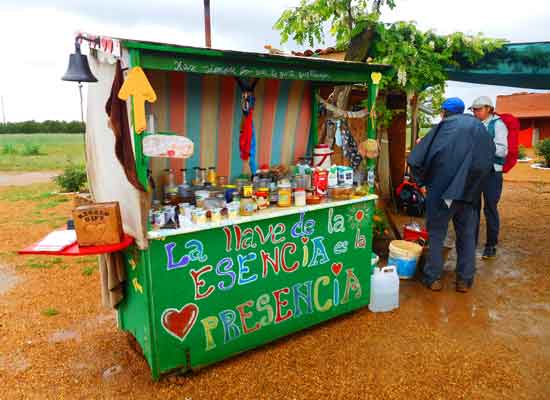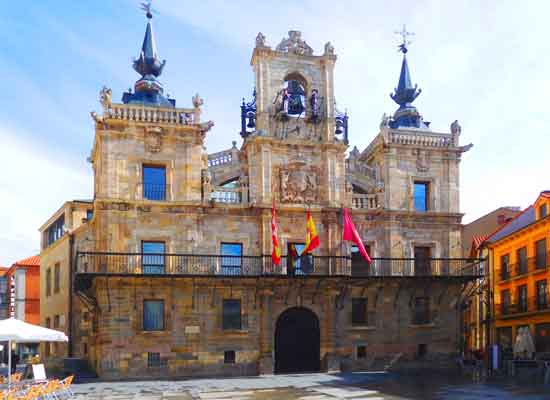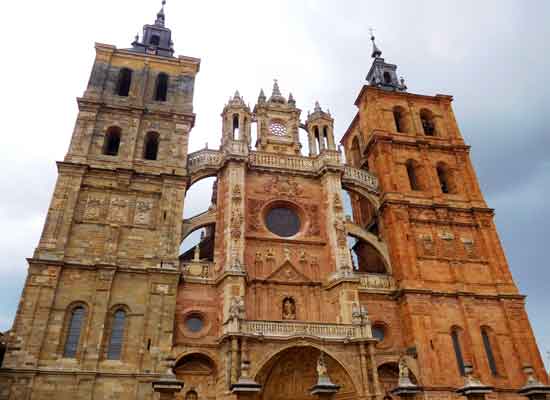Step by Step along The Way of Saint James
From San Martín del Camino to Astorga
1 June 2018
Stage 22 – 23 Km

– It’s raining! –
There’s no doubt about how to dress this morning, and before even leaving the hostel, I put on my poncho and gaiters.
Physically, I feel quite well, and my pains are barely noticeable. I hope this continues throughout the day and, most importantly, that I’m heading toward complete recovery.
– What’s the saying? What doesn’t kill you makes you stronger! –
The hope is to emerge tougher from this tunnel of aches and be able to complete the entire Way.
– I want to stop only when I reach the ocean! –
According to my calculations, including today, there are still eleven stages to Santiago de Compostela and another three to Finisterre—no small number, but I can confidently say that most of it is already behind me.
Giulia, having left Italy unaware of the unusual weather conditions affecting Spain these past weeks, is not well-equipped for the cold and rain.
To protect her shoes from water, I help her create makeshift gaiters using plastic bags and adhesive tape.
The idea works well, although she does look rather comical in this outfit.
In situations like this, however, solving the problem matters far more than appearances—who cares about aesthetics?
Being adventurous also means adapting to circumstances with whatever is at hand.
Rocco, too, adopts the same solution to protect his shoes. To be fair, he had brought proper gaiters but then “wisely” sent them home as part of the package he shipped from Burgos to lighten his backpack.
The first seven kilometers we cover follow a dirt track running parallel to the main road.
The route isn’t particularly enjoyable due to the cars passing close by and the relentless rain that shows no sign of letting up.


We take about an hour and a half to complete this first part of today’s Way, arriving in Hospital de Órbigo shortly after eight o’clock.
Since it’s still raining, we decide to step into a cozy café and eat something to supplement our light breakfast.
The break inside the café turns out to be a blessing because, while we’re there, the rain stops, allowing us to visit the village afterward.
– Hospital de Órbigo is truly charming! –
Finally, a village with the architectural features I had expected to see in many places along The Way.
The small medieval village is highlighted by its spectacular 13th-century stone bridge crossing the river Órbigo.
The bridge, with its twenty arches, stretches approximately 300 meters and has always been a passage for pilgrims heading to Santiago de Compostela.
It gained fame for events dating back to the Holy Year of Saint James in 1434.
Legend has it that Don Suero de Quiñones, a nobleman from León, challenged all knights crossing the bridge to a duel for an entire month to win the love of his lady, Doña Leonor de Tovar.
For this reason, the bridge is also known as the Pass of Honour (Paso honroso).
At the end of the tournament, Don Suero made a pilgrimage to the tomb of the Apostle James.
The event was so significant that even Don Quixote mentions it in the famous book recounting his adventures.
Today, the deeds of Don Suero are reenacted on the first weekend of June with the medieval joust of the “Paso honroso.”
Since today is the 1st of June and a Friday, this year’s celebration will take place over the next two days.
The town will be filled with people dressed in traditional costumes, and medieval music played live will fill the air.
– What a shame to miss the event by just one day! –
We content ourselves with experiencing a small part of the festival’s excitement, limiting ourselves to observing the already decorated bridge and streets adorned with banners and flags.
Our biggest regret, however, is not having stayed overnight here yesterday.
The charm of the village, the joyful atmosphere, and the beauty of the hostels would have made it worthwhile.
We particularly admire the Albergue Parroquial de Peregrinos Karl Leisner on calle Álvarez Vega, set in a lovely traditional building with a welcoming inner courtyard.
The rain holds off during our entire visit, giving us the chance to explore the village and take plenty of photos of its main attractions.
We leave our hearts in Hospital de Órbigo and resume walking at 9:15.
Just outside the village, a fork in the path forces us to make a decision: the left route runs alongside the busy main road, while the right one passes through rural scenery.
This time, the difference in distance between the two routes is minimal, so we choose the slightly longer but more scenic rural path without hesitation.
The dirt track we follow is wide and flat, and the surrounding environment, with few shrubs, feels rather bare.
As we move closer to the green landscapes of Galicia, we start to notice changes in the terrain, and we can already see some hills in the distance.
The dark clouds above allow us to walk without rain for just another fifteen minutes.
By the time we pass through Villares de Órbigo, the heavens open up again.

We keep walking for another couple of hours until, in the middle of nowhere, about ten kilometers before Astorga, La Casa de los Dioses appears before us.
This unique resting spot was established about ten years ago by a Spanish pilgrim.
Under the shade of trees—though not needed today—you can relax in hammocks.
Decorated stalls line the path, adorned with hippie-style designs, hearts, suns, and colorful handwritten signs, offering juices, coffee, milk, teas, fruits, nuts, biscuits, cakes, and more.
Everything is organic and available under the “donativo” system.
We continue walking with Giulia and Rocco for another twenty minutes. At exactly noon, we arrive at Alto de San Justo, the point where the two different routes from Hospital de Órbigo converge.
At this spot, standing at 915 meters above sea level, we are treated to a panoramic view of San Justo de la Vega and Astorga.
Here, we find the Cruz de Santo Toribio, a stone cross resting on a circular stepped base where travelers leave stones as a sign of their passage.
Santo Toribio, Bishop of Astorga from 448 AD, is remembered for bringing the largest known wooden fragment of Christ’s Cross from Jerusalem.
This relic is still preserved and venerated in the monastery named after him, Santo Toribio de Liébana, located in the Cantabrian Mountains near Potes.
The site holds such importance in Christianity that it celebrates its own Holy Year.
It is said that the Saint, after disagreeing with the people of Astorga, left the city and, upon exiting, shook the dust from his sandals while harshly declaring, “… not even the dust of Astorga!”
We still have four kilometers to go, all downhill, before finishing today’s stage. I estimate we’ll reach our destination in about an hour.
Upon entering San Justo de la Vega, we pass a fountain next to a statue of a pilgrim depicted drinking from a “calabaza,” the gourd traditionally used as a water bottle.
Apart from this reference to the past, the bronze figure wears modern hiking boots and clothing.
Beyond San Justo de la Vega, after about two more kilometers, we finally reach Astorga at 12:20.
The twenty-second day of The Way ends at the Albergue de peregrinos Siervas de María, located within an ancient convent.
The hostel is very beautiful, with over 150 beds, and is well-managed by local volunteers who are Friends of The Way. Its central location in the historic heart of the city is also excellent.
Despite being a “five-star” hostel, the price is only 5 Euros.
Overlooking the small square in front of the hostel is a statue of yet another pilgrim.
I find this one even more unusual than the one we saw earlier in San Justo de la Vega.
Normally, such statues depict pilgrims of the past, dressed in rags and wearing sandals.
In this case, however, the figure is clad in a heavy coat, tied at the waist with a broad belt knotted at the front, and wears a wide-brimmed hat reminiscent of a Western style.
But what I find most curious is the large suitcase strapped to his back, held by one hand, resembling the rigid, boxy cardboard cases once used by emigrants.
***
Today, my legs are in better condition, and I can say that I had no major issues for almost the entire walk.
I only felt some mild discomfort during the last half-kilometer, where the asphalt roads and slight incline into the city added some strain.
After taking a shower and doing my laundry, while my friends head out to buy food for lunch and dinner, I make myself comfortable and follow my usual cold therapy routine by applying ice to my shins.
After lunch, I rest for a while and then dedicate the afternoon to exploring the city.
Astorga is a monumental town with about twelve thousand inhabitants and boasts more than two thousand years of history.
It is part of the small Spanish region known as Maragatería.
What’s surprising is how different architectural styles coexist harmoniously here—from ancient Roman designs to the modernist style of Gaudí.
Astorga is also the point where the French Way and the Via de la Plata meet.
The latter is another one of the many routes leading to Santiago de Compostela, named after the ancient Roman consular road.
In this case, the route starts in southern Spain, specifically from Seville.

From the hostel, we reach Plaza Mayor in just a few minutes.
This arcaded, square-shaped plaza is the vibrant heart of the city, hosting the most important festivals and cultural events.
Its central location dates back to Roman times when the forum stood in this very area.
The standout feature of the plaza is the richly decorated Baroque façade of the town hall.
A bit further on, we arrive at Plaza Santocildes, another significant square featuring a monument of a lion triumphing over an eagle.
This sculpture commemorates the city’s heroic defense against French invaders and the various sieges it has endured throughout history.
A few more steps take us to Plaza Obispo Alcolea, where another sculpture grabs our attention.
This time, however, it’s a modern piece created only a few years ago.
Called “Maternidad,” it depicts a large, naked woman seated cross-legged, cradling a child.
At first glance, the sculpture resembles a Botero, but it was actually made by artists Castorina Francisco and Amancio González.


Our stroll through Astorga’s historic center now takes us to discover the city’s two most important monuments, practically located side by side—the Cathedral of Santa María and the Episcopal Palace.
The cathedral, built between the 15th and 18th centuries, incorporates Gothic, Baroque, and Renaissance elements.
Its spectacular façade is a triumph of Baroque art, richly sculpted like a stone altarpiece.
Two square towers flank the façade, identical in every way except for their color tones.
Next to the cathedral stands the Episcopal Palace, which, at first glance, looks more like one of Disney’s fairy-tale castles than a religious building.
In fact, it is a neo-Gothic design by the genius Spanish architect Antoni Gaudí, built between the late 19th and early 20th centuries.
Gaudí abandoned the project due to disagreements with the clients, and other architects completed it, though they failed to follow the original vision.
For example, the three zinc angels Gaudí had planned for the roof were instead placed in the palace garden, where they remain today.
Since 1963, the building has housed the Museum of The Ways, preserving various items related to pilgrimages to Santiago de Compostela.
As usual, we alternate cultural visits with moments of leisurely strolling, where encounters with other pilgrims always offer pleasant opportunities for socializing.
Right in front of Gaudí’s palace, I come across two stocky middle-aged men who look somewhat alike. I’ve already spotted them a few times before, though always from a distance.
What catches my attention is that they’re both wearing the exact same jacket as mine.
Using this coincidence as an icebreaker, I stop them, and we introduce ourselves.
They’re both Brazilian and speak the fascinating language of saudade, evocative of great explorations, literature, music, and so much more.
We exchange a few lighthearted remarks, and before saying goodbye, we take a photo together to highlight our trio of matching jackets.
During our interesting afternoon exploring beautiful Astorga, we’re blessed with pleasant sunshine. However, the weather these days is quite unpredictable, and as our walk comes to an end, the sky suddenly darkens, and large raindrops begin to fall.
We make a quick stop at the supermarket and then hurry back to the hostel to prepare dinner.
While my friends are busy cooking, I take the opportunity to relax and apply ice to my legs again.
By now, these sessions have become a kind of ritual for me—more like a soothing treat after a long day of walking than a therapy for shin pain.
Dinner is good and satisfying, although I regret not going out to try the “cocido maragato,” the region’s traditional dish.
This hearty stew was once a staple for farmers after a hard day’s work.
It’s a one-pot meal, slow-cooked with ingredients from the land—cabbage, chickpeas, and various types of meat.
One curious feature of this stew is that it’s served in reverse order: first the meat, then the vegetables, and finally the soup.
| © Aldo Lardizzone 2020 |  |
CREATIVE COMMONS |
Stage 23 - From Astorga to Foncebadón



